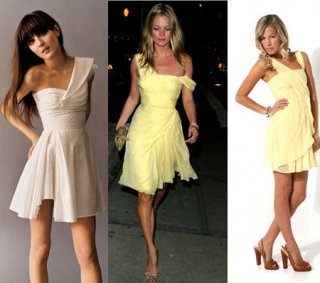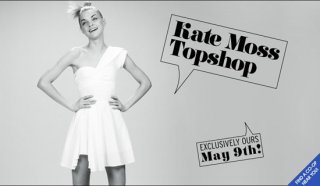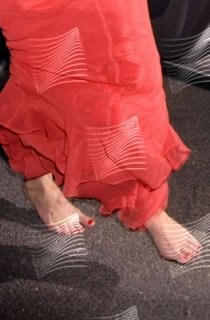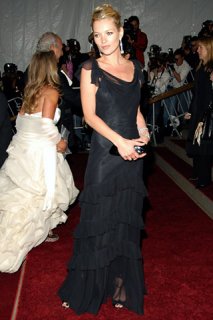excerpt from the IHT
http://www.iht.com/articles/2007/05/07/arts/fkate.php?page=1
NEW YORK: Of all the power couplings that were slated for the Metropolitan Museum's Monday gala - from Julianne Moore with YSL's Stefano Pilati or Selma Hayek with her fiancé François-Henri Pinault - there is one new dynamic duo: Kate Moss and Sir Philip Green.
While the rock chick supermodel is sky-high on the celebrity list, Green, maestro of the cheeky, fast-fashion chain Topshop and emperor of Britain's cheap-and-cheerful "High Street," is no household name in America. But this visit to New York could change all that.
Green, the owner of Arcadia and BHS, is bringing Moss to the United States to launch her as a fashion brand. On Tuesday, the new line of 80 "Kate" pieces is to debut at a party at Barneys, after last week's launch in London. Then Moss had fans queuing round the block at Oxford Circus, while Green orchestrated a dramatic opening. Moss peeked out of the Topshop store windows (the red velvet drapes stubbornly refused to open) and hip chicks raced down the escalator to reach the copies-from-my-closet collection.
As Moss, wearing a long red gown of her own design, shouted "roll up, roll up," was it an ironic take on the spirit of her mentor and backer?
Green, who bought the Arcadia Group, including Topshop, in 2002, is British fashion's ultimate retail showman - so hands-on that, as he clutches a cute teddy bear, destined (he claims) to blow out of his British Home Stores in the holiday season, he emphasizes that this, like 85 percent of the merchandise, is selected with his own "naked" eye.
It is Green himself who went through the "Kate Moss for Topshop" rails, past the pansy print dress and then the sexy striped vest and curvy denim shorts that the media alighted on as "so Kate" - and picked a white cotton dot dress. He ordered 100,000 extra dresses on the spot. That was after he had previewed the range, which the design team put together with Moss, and "made them put another few million pounds" into the clothes to upgrade fabric and finish.
But the question that is gnawing at Green is this: Could he, should he spread his Topshop concept across the pond "not having ever sold a garment in my history in America"?
"We've been doing quite a lot of work on American markets - and there are mixed views of European fast fashion," says Green. "Why is nobody else doing what we do? Is it not wanted?
"I've met with major American retailers. It's trying to get people used to our model: new stock every week. It's the speed of turn - versus American markets which are not as fast as Europe.
"It's a debate with myself. A New York flagship would be a £25 million investment, but I am not going to prove anything by starting in New York. It's trying to understand the American world, the scale of country. Investment is not the issue - once there it has got to work. It's got to be credible - to work in the marketplace. Should we invest in two or three international designers? Do we incorporate American design?"
Yet Topshop remains essentially local. Its stores may be a destination for traveling Japanese, drawn by the powerful if intangible cool factor, but Green has never confronted the Asian market for the same reason he is vacillating over the American one. At the moment, every Topshop garment, from a girlie smock top to cropped pants to the hip range of the equally successful Topman, passes through London.
"We ship it all to England to ship back; we don't have a hub," says Green. "We've got an old-fashioned model. We're going to have to grow up and have an international arm. But it's not just about opening stores. The main store here is 100 yards from the office. Can we execute at this level that far away?"
And it is Bloomingdale's that is eyeing Green and could ultimately be his Topshop partner, according to a New York source familiar with the situation. Green himself says that he has had many American suitors and it is at 19 Barneys stores where Topshop is having its trial American run, to learn "what happens and what sells."
The Kate/Green combo is given an edge because for both partners there is a high-risk factor. The duo famously met over a kiss from Kate - a promise the model made at a charity benefit. Green paid £60,000, passed his gift to Jemima Khan, creating his first link with Moss, who, like him, came from London's blue-collar district of Croydon. Another chance meeting led to the concept of the brand Kate. If it works - and only time will tell if Moss has the creativity and stamina - the line will be a joint plus.
For Moss, 33, Topshop will be her lifeline out of modeling. For Green, her name offers brand value among cutthroat competition, where the ultra-cheap Primark stores are already undercutting Topshop prices and profits.
Green knows that, like America, Moss is high risk. He already lost Jane Sheperdson, the seasoned design head of Topshop, yet this venture has to be more than a one-season-wonder celebrity line. Like a rock star (and particularly since her partner is the erratic rocker Pete Doherty) Moss might implode or become a liability.
Yet there is chemistry to the association of ultra-cool, cockney-sharp Moss and the flamboyant, big-hitter Green. It just could be a fashion marriage made in heaven with an American honeymoon.
Or as Green himself puts it: "I don't do risk. I do educated risk."









